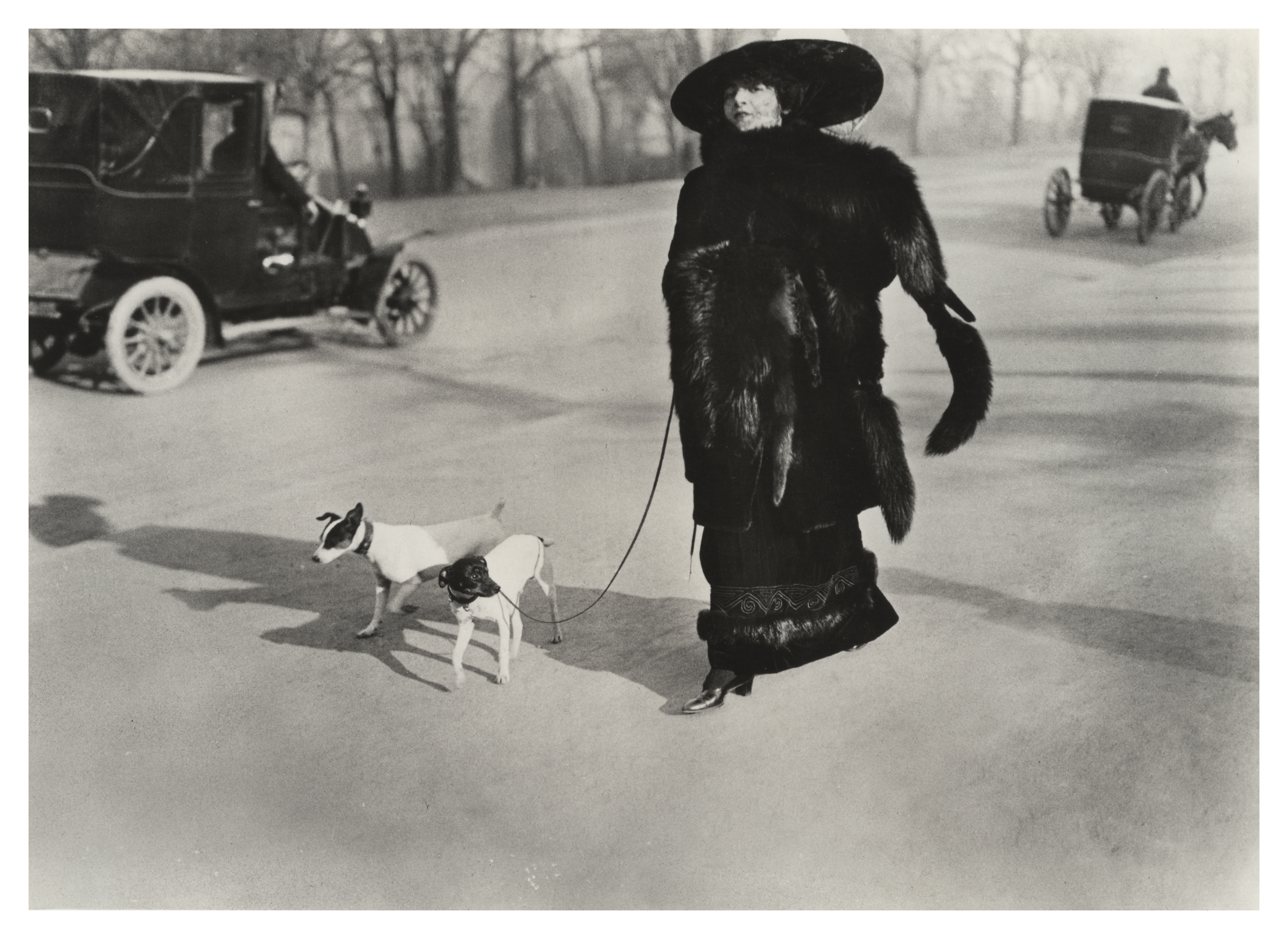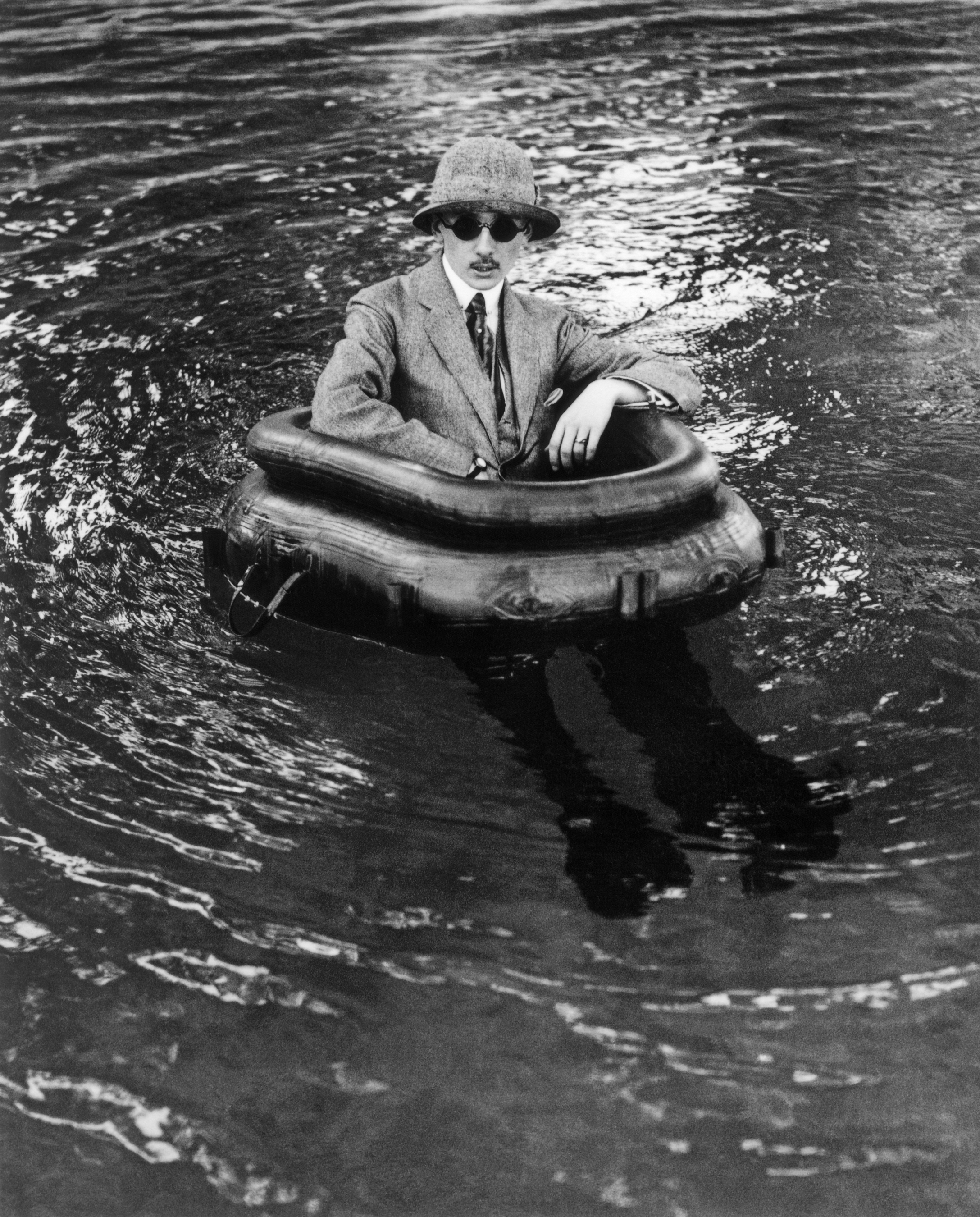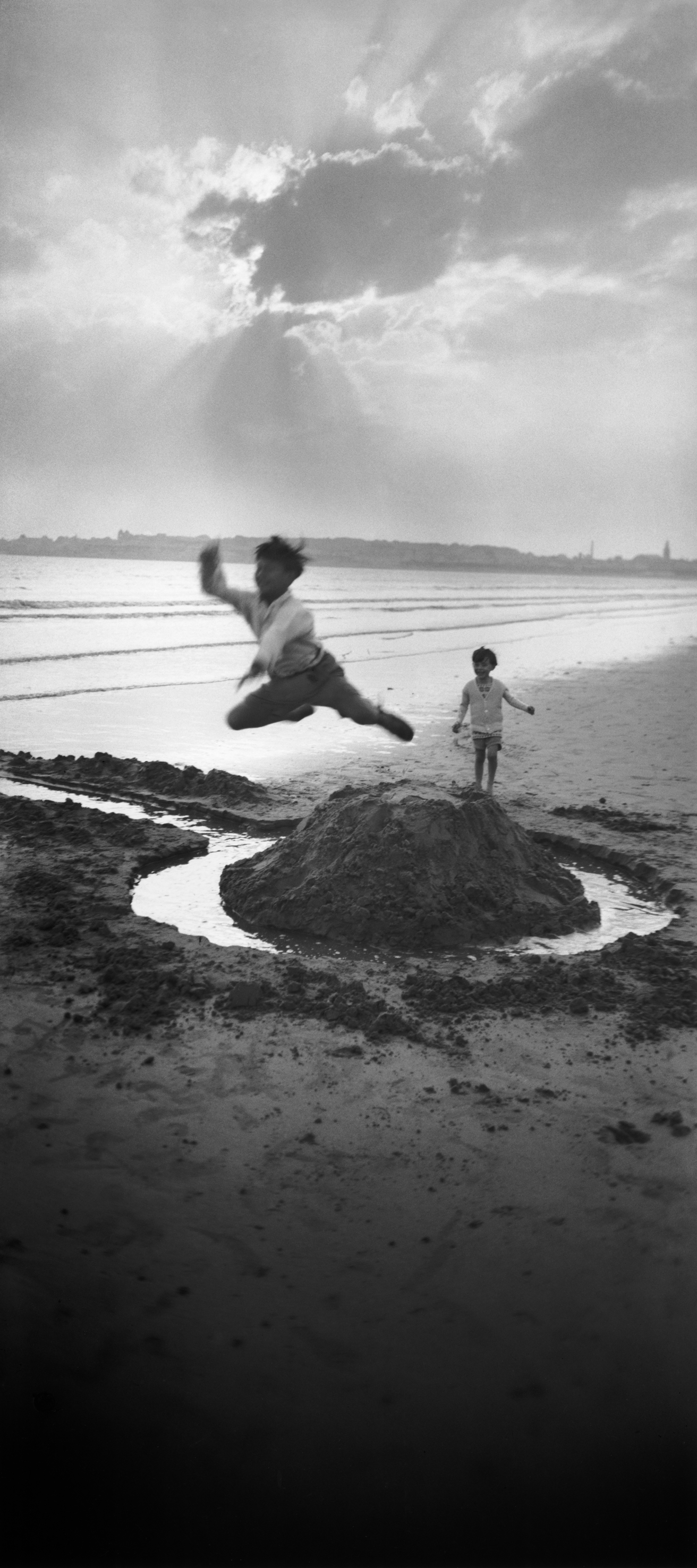Life on the Edge, in Flashback: Lartigue’s Photos at The Frick

Lartigue had an eye that caught a changing world on the fly. This foxy lady of 1911—decked in dead foxes down to the ankles—displays the over-wrapped, woman-as-parade-float style that will soon be as obsolete as the horse-drawn carriage in the distance.
Fans of Jacques Henri Lartigue tend to be passionate. They’re the kind who will travel in from cities beyond Pittsburgh to see the Lartigue show at the Frick Art Museum. The exhibit deserves a trip, and it literally is a trip—a time-travel ride through the opening decades of the 20th century. On view are 135 photographs by the Frenchman famous for capturing the dash of those dizzying years.
Yet to most Americans, even many serious art lovers, the artist’s name barely rings a bell. (Hmm, Lartigue. Was he a fashion designer? Luxury watches? …) For anyone not initiated to the pleasures of his cult, The Frick’s show makes a fine introduction. And the price can’t be beat: Admission to the museum is free.
Civilization, Chickens, and Mirrors
The Frick is calling this exhibit Fast Cars and Femmes Fatales. Plenty of both are pictured, as they were among Lartigue’s favorite pursuits, but there are striking photos of other subjects too. They range from chilling aircraft accidents to mesmerizing waterfront scenes, to amusing impromptu portraits. In one, a distinguished French actor dressed in suit and tie attempts to maintain his cool while smoking a cigarette and holding a pair of live chickens.
I am still trying to figure out why that picture seems to me to speak volumes about the modern history of Western civilization, and probably shouldn’t dwell on it. Here’s the thing, however. The show’s appeal is broader (and more interesting) than the James Bond-y sex appeal implied by its title.
Together, the pictures do convey vivid impressions of the modern world emerging in the early 1900s. And though few of us these days are into nicotine and live poultry, the people in the photos come across eerily as a lot like us, because they lived in rapidly changing times that reflect our own.
The historian Barbara Tuchman titled one of her books A Distant Mirror. She knew that the past can show us a previous version of ourselves. In rows of artful images, the Lartigue show presents a hall of mirrors.

The state-of-the-art gentleman stays high and dry: Lartigue’s brother Maurice, nicknamed Zissou, in a high-tech flotation device with rubber boots.
An Age of Exuberance
Jacques Henri Lartigue was, to begin with, a fortunate son. Born in 1894 to a wealthy and adventurous family, members of the new European industrial elite, he began taking photographs as a child. By his teens, in the years just before World War I, he was taking pictures that would later be recognized as early masterpieces of candid, on-the-scene photography.
Lartigue had arrived at the right time for that genre. Cameras were being made truly portable and were getting fast enough to catch life as it happened. Moreover, along with tools for the task, the young photographer had access through his family to the high life of a new age.
It was a time of high-tech exuberance. “Motoring” was hot and the Lartigues drove the hottest machines. Aviation was both a new science and an extreme sport, and Lartigue didn’t pilot the extremely risky aircraft of the day, but he was an on-the-ground witness. Women were becoming ever feistier—more liberated, relatively speaking—and Lartigue, who would romance many and marry a few, traced their progression in photos spanning eras from pre-World War I through the Roaring Twenties and later.
That’s the nature of what is being shown at The Frick.
Flying through Time
The exhibit’s first gallery alone, with the earliest photos, is worth a visit. Two counterpoint images: On one wall, Lartigue’s first wife, Bibi, is ready to rock the road. Swathed for open-car motoring in a head cowl and duster suit, she’s beaming wide-eyed through a pair of goggles. On another wall is a crashing airplane caught nose-down and shedding parts at the moment of impact.

Hip to the times, the new woman of 1930 was Lartigue’s model Renée Perle.
Women viewing the exhibit, the day I went, howled with laughter at the fashionable females in pre-war society photos. The gals are wrapped and festooned like human Christmas trees, balancing hats that would challenge Carmen Miranda. But then, as you move through the show, you can see the women unwrapping into the flapper age while the world evolves from a cluttered and dodgy steampunk state to a sleeker one.
The main femmes fatales pictures are a series of posed portraits of Lartigue’s 1930s lover, a Romanian model, and his third and final wife, Florette, whom he met in 1941. Both are out-there glamorous and they bring the heat, each in her own way. One could spend a good bit of time reflecting on what these photos say about the power of women, the objectification of women, and the eye of the beholder.
One subject not shown in the exhibit: the epochal carnage of World War I. Lartigue wasn’t at the front, either as a combatant or photographer. A quality found throughout the show, in photos of many kinds: excellent composition.
And “composition” in visual art is more than a mere technical skill, aimed at making a pretty picture. It determines the picture’s ability to draw you in, evoking a mood or a spirit.

Sky boys: young Gérard Willemetz and Lartigue’s son Dani, 1926.
One spirit evoked time and again in Lartigue’s photos is the urge to fly—literally. He loved to take pictures of people leaping in midair: boys at play, divers diving, ice skaters kicking high and lifting off, a muscular beach dude going ‘way up and over in a front-flip.
They leaped; they flew; sometimes they came down hard. So do we.
Postscripts: the Long View, the Teen View
Lartigue lived long enough to see the Concorde jetliner and the Apple Macintosh. He died at 92 years of age, in 1986. For many years he had pursued a career as a painter, with some success, considering photography to be mostly an avocation. That changed in the 1960s when albums of his photos got into a museum director’s hands and he was belatedly “discovered.” The rest is, well, history.
In his last years Lartigue deeded all his negatives, albums, and such to the French government. The exhibit at The Frick was put together under the auspices of France’s Ministry of Culture. It had been sent on tour previously, in 1994 (the 100th anniversary of Lartigue’s birth), but the show currently has only one stop in North America: here in Pittsburgh.
Sarah J. Hall, director of curatorial affairs at The Frick, led the move to bring the photos here. She sees them as exceptional in how they combine artistic impact with historical value. “If you think pre-1920s black-and-white photographs are boring, Lartigue will change your mind,” Hall said. “And when he captured these slices of time, in the transition from the Gilded Age to the modern world, he seemed very aware of what he was doing.”
Hall noted that Lartigue’s first waves of great photos have often been characterized as the work of a “naïve boy genius,” a view she doesn’t quite agree with. Despite his youth, Lartigue had already learned to be skilled at using cameras, and though he did bring a fresh eye to the page-turning events that he photographed, it was hardly a babe’s eye. As Hall put it, “He was a teenager! They can see what’s going on.”
Visitor Info
Fast Cars and Femmes Fatales: The Photographs of Jacques Henri Lartigue is up through May 15 in the Frick Art Museum at the Frick Art & Historical Center, 7227 Reynolds St., Point Breeze. Related special events include screenings of feature films by Wes Anderson, who cites Lartigue as an artistic influence. For times and information visit The Frick’s website or call 412-371-0600.
Image credits: All photographs by Jacques Henri Lartigue are © Ministry of Culture—France/AAJHL.
Mike Vargo, a Pittsburgh-based writer and editor, covers visual arts for Entertainment Central.
Share on Social Media
Follow Entertainment Central
Latest Stories
Sign up for the EC Newsletter







